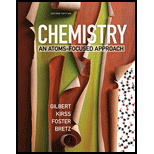
To find:
a) Calculate the fuel value of
b) How much heat is released during the combustion of
c) How many grams of
d) Assume white gas is 25%
Answer to Problem 9.110QA
Solution:
a) Fuel value of
b)
c)
d)
Explanation of Solution
1) Concept:
Fuel value is the amount of energy generated by complete combustion of a particular mass of fuel (hydrocarbon,
This can be calculated from the enthalpy change for combustion reaction.
From the heat of combustion of
The amount of energy required to raise the temperature can be calculated using mass, specific heat, and change in temperature,
i.e.
where,
2) Formula:
i.
ii.
3) Given:
i)
ii) Amount of
iii) Amount of water
iv) Initial temperature of water =
v) Final temperature of water =
vi) White gas =
vii) Fuel value of
4) Calculation:
a) Calculating fuel value of
Heat of combustion per mol is the amount of energy released in complete combustion of 1 mol of that substance.
Heat of combustion
Mass of
Therefore, the fuel value of
Thus, the fuel value for
b) Calculating the heat released during the combustion of
Converting mass in
Calculating moles from given mass using molar mass as
Molar mass of
Heat released for
c) Calculating amount of
Assume that all the heat released during combustion is used to heat the water. Hence, the amount of energy gained by water will be equal to amount of energy released by the combustion of
i.e.,
Converting the mass of water from
Therefore, energy required to increase the temperature of
Plug in the given values:
Therefore,
Here, we assume that all heat, which is required to heat water, is coming from the combustion of
Converting moles to mass using molar mass as
Therefore,
d) Calculating the amount of white gas needed to heat
White gas =
Fuel value of
Fuel value of
Thus, the total fuel value of white gas is
The energy required to increase the temperature of
So, the mass of white gas required to released
Therefore,
Conclusion:
Fuel value for the mixture of hydrocarbons is calculated using the proportion in which they are mixed.
Want to see more full solutions like this?
Chapter 9 Solutions
Chemistry: An Atoms-Focused Approach (Second Edition)
- Please help me Please use https://app.molview.com/ to draw this. I tried, but I couldn't figure out how to do it.arrow_forwardPropose a synthesis of 1-butanamine from the following: (a) a chloroalkane of three carbons (b) a chloroalkane of four carbonsarrow_forwardSelect the stronger base from each pair of compounds. (a) H₂CNH₂ or EtzN (b) CI or NH2 NH2 (c) .Q or EtzN (d) or (e) N or (f) H or Harrow_forward
- 4. Provide a clear arrow-pushing mechanism for each of the following reactions. Do not skip proton transfers, do not combine steps, and make sure your arrows are clear enough to be interpreted without ambiguity. a. 2. 1. LDA 3. H3O+ HOarrow_forwardb. H3C CH3 H3O+ ✓ H OHarrow_forward2. Provide reagents/conditions to accomplish the following syntheses. More than one step is required in some cases. a. CH3arrow_forward
- Identify and provide an explanation that distinguishes a qualitative and quantitative chemical analysis. Provide examples.arrow_forwardIdentify and provide an explanation of the operational principles behind a Atomic Absorption Spectrometer (AAS). List the steps involved.arrow_forwardInstructions: Complete the questions in the space provided. Show all your work 1. You are trying to determine the rate law expression for a reaction that you are completing at 25°C. You measure the initial reaction rate and the starting concentrations of the reactions for 4 trials. BrO³¯ (aq) + 5Br¯ (aq) + 6H* (aq) → 3Br₂ (l) + 3H2O (l) Initial rate Trial [BrO3] [H*] [Br] (mol/L) (mol/L) | (mol/L) (mol/L.s) 1 0.10 0.10 0.10 8.0 2 0.20 0.10 0.10 16 3 0.10 0.20 0.10 16 4 0.10 0.10 0.20 32 a. Based on the above data what is the rate law expression? b. Solve for the value of k (make sure to include proper units) 2. The proposed reaction mechanism is as follows: i. ii. BrО¸¯ (aq) + H+ (aq) → HBrO3 (aq) HBrO³ (aq) + H* (aq) → H₂BrO3* (aq) iii. H₂BrO³* (aq) + Br¯ (aq) → Br₂O₂ (aq) + H2O (l) [Fast] [Medium] [Slow] iv. Br₂O₂ (aq) + 4H*(aq) + 4Br(aq) → 3Br₂ (l) + H2O (l) [Fast] Evaluate the validity of this proposed reaction. Justify your answer.arrow_forward
 ChemistryChemistryISBN:9781305957404Author:Steven S. Zumdahl, Susan A. Zumdahl, Donald J. DeCostePublisher:Cengage Learning
ChemistryChemistryISBN:9781305957404Author:Steven S. Zumdahl, Susan A. Zumdahl, Donald J. DeCostePublisher:Cengage Learning ChemistryChemistryISBN:9781259911156Author:Raymond Chang Dr., Jason Overby ProfessorPublisher:McGraw-Hill Education
ChemistryChemistryISBN:9781259911156Author:Raymond Chang Dr., Jason Overby ProfessorPublisher:McGraw-Hill Education Principles of Instrumental AnalysisChemistryISBN:9781305577213Author:Douglas A. Skoog, F. James Holler, Stanley R. CrouchPublisher:Cengage Learning
Principles of Instrumental AnalysisChemistryISBN:9781305577213Author:Douglas A. Skoog, F. James Holler, Stanley R. CrouchPublisher:Cengage Learning Organic ChemistryChemistryISBN:9780078021558Author:Janice Gorzynski Smith Dr.Publisher:McGraw-Hill Education
Organic ChemistryChemistryISBN:9780078021558Author:Janice Gorzynski Smith Dr.Publisher:McGraw-Hill Education Chemistry: Principles and ReactionsChemistryISBN:9781305079373Author:William L. Masterton, Cecile N. HurleyPublisher:Cengage Learning
Chemistry: Principles and ReactionsChemistryISBN:9781305079373Author:William L. Masterton, Cecile N. HurleyPublisher:Cengage Learning Elementary Principles of Chemical Processes, Bind...ChemistryISBN:9781118431221Author:Richard M. Felder, Ronald W. Rousseau, Lisa G. BullardPublisher:WILEY
Elementary Principles of Chemical Processes, Bind...ChemistryISBN:9781118431221Author:Richard M. Felder, Ronald W. Rousseau, Lisa G. BullardPublisher:WILEY





